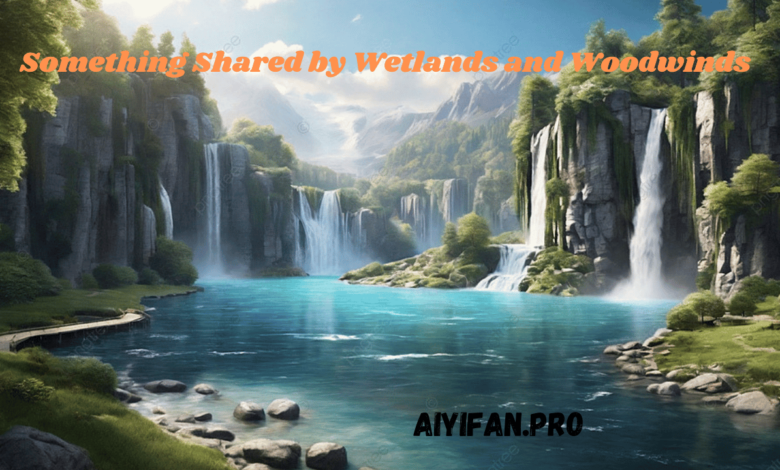Something Shared by Wetlands and Woodwinds: A Harmonious Connection

When we think of wetlands, we picture vast landscapes of marshes, swamps, and bogs, teeming with wildlife and rich biodiversity. On the other hand, woodwinds bring to mind the soulful melodies of instruments like flutes, clarinets, and oboes. At first glance, these two realms may seem worlds apart, yet they share fascinating connections that reveal the profound interplay between nature and music.
The Soundscapes of Wetlands
Wetlands are unique ecosystems where water meets land, creating habitats that support a wide array of flora and fauna. One of the most enchanting aspects of wetlands is their soundscapes. The chorus of bird calls, the croaking of frogs, and the rustling of reeds in the breeze create a natural symphony that is both soothing and vibrant.
This cacophony of sounds is not just noise but an essential part of the ecosystem. Birds use calls to communicate, attract mates, and ward off predators. Frogs croak to mark their territory and attract partners. These sounds play a crucial role in the survival and reproduction of wetland species.
The Melodies of Woodwinds
Woodwind instruments are a fundamental part of orchestras and various musical traditions worldwide. Instruments like the flute, clarinet, oboe, and bassoon produce sound by blowing air across an opening or through a reed. The materials used to make these instruments are often derived from natural sources, linking them to ecosystems like wetlands.
For instance, reeds used in instruments like the oboe and clarinet are often harvested from wetlands. The Arundo donax, commonly known as giant reed, is a species native to wetlands in the Mediterranean but has been cultivated worldwide for its use in making reeds for woodwind instruments. This plant thrives in wetland conditions, directly connecting the instruments and these unique ecosystems.
Shared Acoustic Qualities
Both wetlands and woodwinds share a common trait in their acoustic properties. Wetlands are natural amphitheaters where sounds travel and resonate, creating an immersive auditory experience. Similarly, woodwind instruments are designed to produce precise, resonant tones that carry well in concert halls and outdoor settings.
The study of soundscapes in wetlands, known as ecoacoustics, reveals how these environments create complex auditory experiences. The structure of vegetation, the presence of water, and the types of animals all contribute to the unique sounds of a wetland. Similarly, the design and material of woodwind instruments are carefully crafted to produce specific sound qualities, making them a perfect match for the acoustics of performance spaces.
Materials Connecting Wetlands and Woodwinds
The materials used in crafting woodwind instruments often originate in wetland environments. Beyond reeds, other materials, such as wood from trees growing in wetland areas, are used. For example, grenadilla wood (African blackwood) is commonly used for clarinets and oboes due to its density and tonal qualities. These trees typically grow in savanna and dry forest regions but require specific wetland-like conditions for optimal growth.
Moreover, bamboo, which grows abundantly in wetland areas, is used to make flutes in many cultures. The bamboo flute, or shakuhachi in Japan, is renowned for its rich, mellow sound that mimics the natural sounds of its wetland origins.
Environmental and Cultural Significance
Wetlands are critical for environmental health. They capture sediments and contaminants in their natural capacity as water filters and play a vital role in flood control by absorbing excess rainfall. Additionally, wetlands store carbon, helping mitigate climate change. The preservation of wetlands is crucial not just for the wildlife they support but for maintaining the ecological balance of our planet.
While not directly linked to environmental functions, woodwind instruments carry significant cultural and historical importance. Music has been a part of human culture for millennia, and woodwinds have played a vital role in various musical traditions. From the ancient bamboo flutes of Asia to the sophisticated clarinets and oboes of Western classical music, these instruments reflect the ingenuity and creativity of human societies.
Conservation and Sustainability
The link between wetlands and woodwinds underscores the importance of sustainable practices. Overharvesting of reeds and deforestation for wood can threaten wetland ecosystems and the species that depend on them. Sustainable harvesting practices and conservation efforts are essential to protect these environments and ensure the continued availability of materials for musical instruments.
Organizations and musicians are increasingly aware of the need for sustainable practices. Some companies are exploring synthetic alternatives to natural reeds, while others are investing in reforestation and wetland restoration projects. By supporting these initiatives, musicians, and consumers can help preserve the delicate balance between nature and music.
Conclusion
The connection between wetlands and woodwinds is evidence of the complex relationships found throughout our natural world. Wetlands provide the raw materials and inspiration for creating woodwind instruments, while both share unique acoustic properties that enrich our auditory experiences. This relationship’s environmental and cultural significance highlights the importance of preserving wetlands and promoting sustainable instrument-making practices.
FAQs on “Something Shared by Wetlands and Woodwinds: A Harmonious Connection”
Q1: What are wetlands, and why are they important?
Q2: How do wetlands contribute to the soundscapes of nature?
Q3: What are woodwind instruments, and how do they produce sound?
Q4: What is the connection between wetlands and the materials used in woodwind instruments?
Q5: What are the acoustic similarities between wetlands and woodwind instruments?
You May Also Read: Unveiling the Mysteries of Ainonib.ri: A Comprehensive Exploration




